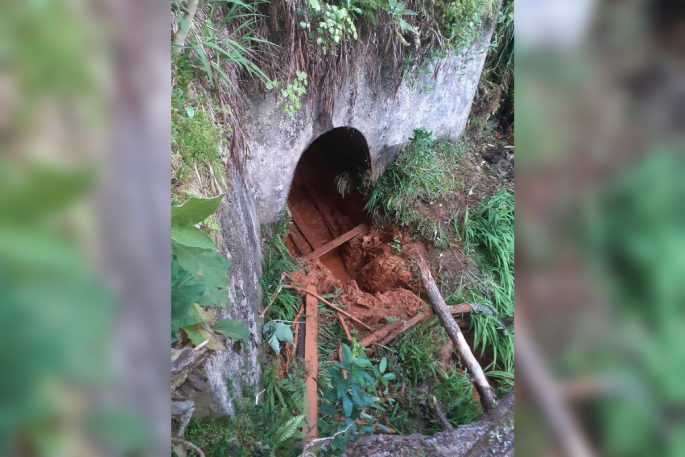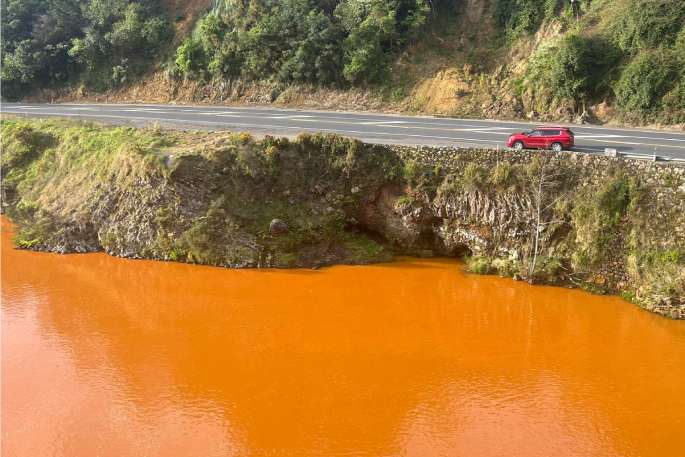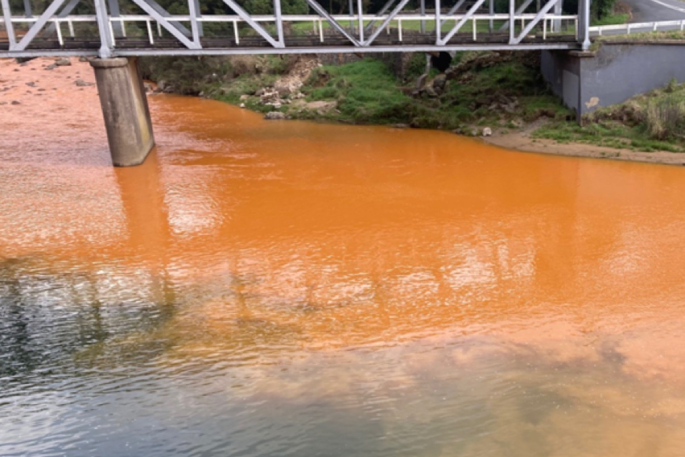A discharge of brightly coloured orange water into Karangahake Gorge’s Ohinemuri River on Friday afternoon has now mostly cleared, with the river returning to its normal colour, says a Paeroa local.
The rush of discoloured sludge and water appears to have flowed out of Scotchman's Gully [also known as Scotsman's Gully] into the main river about 3pm on Friday, quickly turning the water flowing through Karangahake Gorge bright orange.
“There’s only sediment along the edges [of Ohinemuri River] and that should wash through with all this rain,” says Paeroa Towing Services owner Michael Small.
 The Ohimemuri River on Saturday morning with some orange colouring still appearing along the sides of the gorge. Photo: Michael Small/Paeroa Towing Services.
The Ohimemuri River on Saturday morning with some orange colouring still appearing along the sides of the gorge. Photo: Michael Small/Paeroa Towing Services.
“There’s nothing dead lying around. I checked to see, and there’s no dead fish or dead eels," says Michael.
“And there’s nothing coming out of Scotchman’s Gully.”
-(1).jpg) The source of the orange discharge on Friday appeared to be from the hillside above the Ohinemuri River. Photo: Shelley Gracie.
The source of the orange discharge on Friday appeared to be from the hillside above the Ohinemuri River. Photo: Shelley Gracie.
Shelley Gracie, her husband Lance Gracie and mother Diane Patrick, were driving through Karangahake Gorge from the Paeroa end about 3.15pm on Friday when they noticed the water had turned a strange orange colour.
“We pulled over into the car park area and saw that this was where the coloured water was coming from,” says Shelley.
“It appeared to be coming out of the bank.”
-(1).jpg) The orange discharge flowing into the Ohinemuri River on Friday afternoon. Photo: Shelley Gracie.
The orange discharge flowing into the Ohinemuri River on Friday afternoon. Photo: Shelley Gracie.
-(1).jpg) The orange discharge starts to spread further along the Ohinemuri River on Friday afternoon. Photo: Shelley Gracie.
The orange discharge starts to spread further along the Ohinemuri River on Friday afternoon. Photo: Shelley Gracie.
They took photos showing the source of the bright orange colour and how it had dispersed into the Ohinemuri River.
“A lady walking along the bank said that she thought it was from a burst tailings dam, and that it would likely contain arsenic and cyanide.”
 Mitch Podger followed the discharge of orange into the Ohinemuri River back to its source, the entrance to the Comstock mine, which is over 120 years old. Photo: Mitch Podger.
Mitch Podger followed the discharge of orange into the Ohinemuri River back to its source, the entrance to the Comstock mine, which is over 120 years old. Photo: Mitch Podger.
Mitch Podger who lives in Waihi, saw a Facebook post about the discoloured water about 4.30pm.
“I decided to go for a further look,” says Mitch. “We hang out around the gorge all the time, walking, swimming.”
.jpg) Mitch Podger followed the discharge of orange into the Ohinemuri River back to its source. Photo: Mitch Podger.
Mitch Podger followed the discharge of orange into the Ohinemuri River back to its source. Photo: Mitch Podger.
He took his eight-year-old son Tyler, and dog Lucy with him to take a look up through Scotchman’s Gully, taking photos until he reached the source, which he says is an old mine shaft.
“The pics at the bottom of Scotsman's Gully, 20 metres from where it enters the main Ohinemuri River. It's definitely a mine shaft.”
.jpg) A photo of the old Comstock mine entrance taken earlier this year shows the level of water and mud was at least 700mm higher than it is now that the sludge has poured out down the hill into the Ohinemuri River. Photo: N.Z. History Seekers Facebook page.
A photo of the old Comstock mine entrance taken earlier this year shows the level of water and mud was at least 700mm higher than it is now that the sludge has poured out down the hill into the Ohinemuri River. Photo: N.Z. History Seekers Facebook page.
Scotchman's Gully has a small stream flowing through it and for most of the way small ferns cover the banks. Scotchman's Gully track leads from the main car park in Karangahake Gorge, following the stream, and on to the Mount Karangahake walk.
Describing the colour of the water, Mitch says “it's pretty cool, powerful colouring".
“Looks like a fallen pine tree may have helped dam the old mine up- and you can see by the higher colour marks that it had a much bigger flow/ output earlier.”
.jpg) Mitch Podger followed the discharge of orange into the Ohinemuri River back to its source - the entrance to the Comstock Mine. Photo: Mitch Podger.
Mitch Podger followed the discharge of orange into the Ohinemuri River back to its source - the entrance to the Comstock Mine. Photo: Mitch Podger.
In a video Mitch filmed, he refers to a fallen pine tree.
“Looks to me like it's acted as a natural dam.”
His video and photos show the entrance to an old tunnel or mine shaft, which N.Z History Seekers Facebook page says is the Comstock Mine.
“Council was turning up as we got there, and were testing water when we were leaving,” says Mitch, who gave his dog Lucy a good wash down following their walk up into the bush.
Staff from Waikato Regional Council staff are checking the old mine shaft today.
“Staff will check on Saturday morning whether the mine shaft is the source of the discolouration and whether sediment would continue to discharge,” says regional compliance manager Patrick Lynch.
 The orange discolouration spread along Ohinemuri River in the Karangahake Gorge on Friday evening. Photo: Davidda Hikatangata.
The orange discolouration spread along Ohinemuri River in the Karangahake Gorge on Friday evening. Photo: Davidda Hikatangata.
The council are also tracking the plume of discolouration, which they estimate could reach the Firth of Thames between 9am and 10am today.
"Efforts are being made to understand what the plume looks like now, and what the effects may be on the river and the Firth of Thames," says Patrick.
People are reminded to treat the water as contaminated.
On Friday, Hauraki District Council posted a statement to their Facebook page, assuring the public that the Paeroa water supply, which is upstream of the discoloured water is not affected.
“We are aware of an issue turning the water in the Ohinemuri River orange. This is likely from water coming out of old mine workings,” says a Hauraki District Council spokesperson posting to Facebook.
“Waikato Regional Council is investigating the issue and advise for safety reasons, please do not enter the water. Our Paeroa water supply intake is upstream of this so is not affected however we'll be monitoring the situation carefully.”
On Friday evening Waikato Regional Council urged people to treat bright orange discolouration of the Ohinemuri River as contaminated.
Senior Incident Response Officer Robert Isaac said then that the worst case scenario is the discoloured water is due to a mine shaft collapse, and old mines contain many heavy metals and contaminants.
The incident was reported to the council at about 3pm on Friday and council staff went to the river to assess the discoloration.
 The orange discolouration spread along Ohinemuri River in the Karangahake Gorge on Friday evening. Photo: Waikato Regional Council.
The orange discolouration spread along Ohinemuri River in the Karangahake Gorge on Friday evening. Photo: Waikato Regional Council.
On Friday evening, Isaac said staff had yet to identify the source of the discolouration, which he said appears to enter the Ohinemuri River downstream of the Waitawheta River.
“Until we can ID the source we need to treat this as worst case scenario as we are getting reports of people standing in the water,” says Isaac.
“If this is an old mine shaft that has blown out than people should not be using or touching the water.”
He says other scenarios could include a collapsed out forestry dam or other erosion.
During the 1890s millions of tons of tailings containing poisonous cyanide and debris from mining were dumped into the Ohinemuri River and carried downstream.
With old mine shafts in the area, the most likely cause of the orange would be the release of iron-rich minerals into the water. When they, particularly iron sulphides like pyrite (FeS2), are exposed to water and oxygen, they oxidize and produce iron oxide and the water turns orange.
With acid mine drainage, the oxidation of sulphide minerals not only releases iron but also produces sulphuric acid. The acid can then further dissolve other heavy metals from the mine, which would then compound the environmental impact.
The orange colour is due to the formation of ferric hydroxide (Fe(OH)3), which is a rust-like substance that precipitates out of the water.

.jpg)

1 comment
OLD MINE SHAFT
Posted on 24-08-2024 20:07 | By The Caveman
BUGGER - how many MILLIONS do they want to spend to stop it ??? And have they got the TECH to do so ??
Leave a Comment
You must be logged in to make a comment.